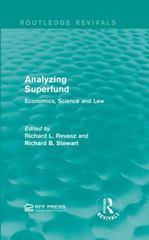Question
1 Which of the following would you expect to lead to worsening environmental quality? A) An export or production subsidy from the Chinese government to
1 Which of the following would you expect to lead to worsening environmental quality?
A) An export or production subsidy from the Chinese government to Chinese steel manufacturers
B) Freer trade in capital equipment that incorporates environmentally friendly technologies
C) An export subsidy for producers of clean technology for producing paper D) Freer trade that promotes production of manufactured goods in developing countries where environmental laws are strict
2 Which of the following statements is true?
A) Evidence shows that measures to keep the environment clean represent a large percentage of the total costs of production for a firm in a country with strict environmental laws.
B) There are large incentives for firms to relocate from countries with strict environmental laws to countries with lax environmental regulation.
C) Firms are unlikely to relocate their high-pollution production to countries with lax environmental laws because they fear that such moves will result in adverse effects on their reputations.
D) Imposition of a tax on the production of a particular high-pollution product typically has a greater impact on consumer surplus than on producer surplus.6
3 For which of the following types of environmental pollution can we expect that the level of environmental harm would increase as per capita income increases?
A) Carbon dioxide emissions
B) Lead pollution in water
C) Carbon monoxide
D) Arsenic in water
4 For which of the following environmental pollutions would we expect that an inverted-U relationship would exist between environmental harm and per capita income?
A) Carbon dioxide emissions
B) Lead pollution in water
C) Sulfur dioxide in air
D) Airborne heavy particles
5 As the world moves toward freer trade, the composition of production shifts so that more environmentally "dirty" products are produced in ________ and more environmentally "clean" products are produced in
A) industrialized countries; developing countries.
B) developing countries; industrialized countries.
C) both industrialized and developing countries; only industrialized countries.
D) developing countries; neither industrialized nor developing countries.
6 As a result of the Uruguay Round, production of ________ goods increased in Asian developing countries and polluting emissions in these countries ________ as a result.
A) capital and skill-intensive; decreased
B) capital and skill-intensive; increased
C) unskilled-labor-intensive; decreased
D) unskilled-labor-intensive; increased
7 As a result of the Uruguay Round, production of ________ goods increased in industrialized countries and polluting emissions in these countries ________ as a result.
A) capital and skill-intensive; decreased
B) capital and skill-intensive; increased
C) unskilled-labor-intensive; decreased
D) unskilled-labor-intensive; increased
8 The combined size and income effects of the Uruguay Round tend to
A) decrease nitrogen dioxide emissions in the European Union and Japan. B) increase carbon monoxide emissions in developed countries.
C) increase pollution levels in developing countries.
D) decrease pollution levels worldwide by more than one percent.7
9 Which of the following statements about trade and domestic pollution is accurate?
A) Free trade is likely to cause producers to reduce their levels of pollution due to international competition.
B) It is possible for free trade to hurt a country if polluters are forced to internalize the external costs associated with their production.
C) In the presence of free trade, the costs of pollution can be transferred almost completely by the exporting country to the importing country.
D) If polluters are not forced to internalize the external costs associated with their production, free trade could result in the country exporting the wrong products.
10 Which of the following is an example of an international externality, in which production (or consumption) activities in one country impose external costs on other countries?
A) Transborder pollution
B) Persistent dumping
C) Free-riding
D) Moral hazard
11 Which of the following statements about trade and domestic pollution is accurate?
A) Free trade is likely to cause producers to reduce their levels of pollution due to international competition.
B) It is possible for free trade to hurt a country if polluters are forced to internalize the external costs associated with their production.
C) In the presence of free trade, the costs of pollution can be transferred almost completely by the exporting country to the importing country.
D) If polluters are not forced to internalize the external costs associated with their production, free trade could result in the country exporting the wrong products.
12 Which of the following is an example of an international externality, in which production (or consumption) activities in one country impose external costs on other countries?
A) Transborder pollution
B) Persistent dumping
C) Free-riding
D) Moral hazard
13 When domestic production causes pollution that imposes an external cost on the country, the country may export the wrong products because, A) the price of the product should be lower, which could lead to less production of the product.
B) the price of the product should be lower, which could lead to no exports of the product.
C) the price of the product should be higher, which could lead to more exports of the product.
D) the price of the product should be higher, which could lead to no exports of the product
Step by Step Solution
There are 3 Steps involved in it
Step: 1

Get Instant Access to Expert-Tailored Solutions
See step-by-step solutions with expert insights and AI powered tools for academic success
Step: 2

Step: 3

Ace Your Homework with AI
Get the answers you need in no time with our AI-driven, step-by-step assistance
Get Started


